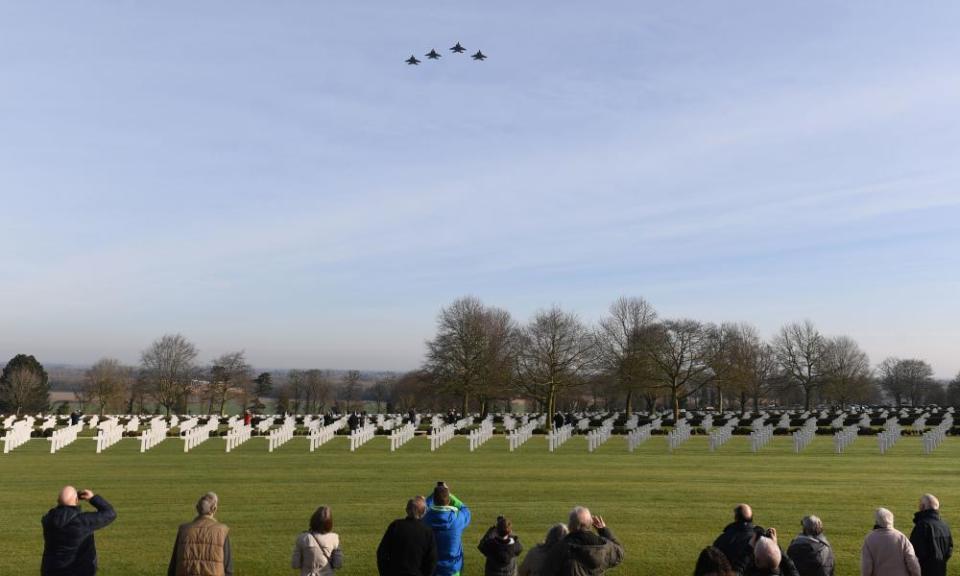Sheffield flypast pays tribute to US airmen killed in wartime crash

Thousands have gathered in Sheffield to watch the US air force stage a flypast to commemorate 10 plane crew who died during the second world war.
People travelled from around the world for the flypast, including military veterans and family members of soldiers who were killed on the B-17 Flying Fortress aircraft, known as Mi Amigo.
The event was watched by Tony Foulds, 82, who saw the Mi Amigo crash while he was playing with friends in the park as a child.
He later learned the aircraft had been attempting a crash landing in the park – the only green space for miles – but diverted course for fear of harming Foulds and his friends. Since 1944 he has quietly tended to a memorial for the US airmen.
On Friday, British and US military aircraft were dispatched from the UK’s largest US air force base in Suffolk, before flying over Endcliffe Park in Sheffield at 8.45am.

It was an important day for locals, who travelled to the public event on free buses and trams. One woman in the crowd turned to her daughter and said: “We’ve made history today, haven’t we?”
Foulds said he could not believe the flypast was finally happening. But he had something bigger on his mind. “I just can’t wait to see them planes go past now,” he said.
Foulds, who has Parkinson’s disease, became an internet sensation when the BBC journalist Dan Walker stumbled across him one morning while out walking his dog.
Just met an amazing man in Endcliffe Park, Sheffield. Tony Foulds was an 8-yr-old playing in the park when a US plane crashed in Feb 1944. He has diligently maintained the memorial ever since. He was planting new flowers. Almost 75 yrs of service. What a man. I’m in bits 😢👏🏻 pic.twitter.com/DpdDmSZ0F3
— Dan Walker (@mrdanwalker) January 2, 2019
Walker began an online campaign to make Foulds’ dream come true: to properly commemorate the air crew who died, with a flypast.
“I was just touched by the fact that this 82-year-old had been tending this memorial quietly, diligently and without any desire for publicity or fame,” Walker said.
“He never once asked for anything for himself – his whole focus was always on honouring the men of Mi Amigo and that is why I felt I had to do all I could to make it happen.”
A message from Walker, who is in Kenya, was broadcast from a BBC stage to crowds holding placards reading: “Dan Walker is a legend!” Up to 10,000 people were estimated to have attended the event.
The Mi Amigo flew over the Sheffield park 75 years ago, having returned from a final mission in Denmark, where the Luftwaffe left it badly damaged. The 10 soldiers on board were:
Pilot Lt John Kriegshauser, from Missouri
Co-pilot 2nd Lt Lyle Curtis, from Idaho
2nd Lt John Humphrey, a navigator from Illinois
Sgt Melchor Hernandez, a bombardier from California
Sgt Harry Estabrooks, an engineer and gunner from Kansas
Sgt Charles Tuttle, gunner from Kentucky
Sgt Robert Mayfield, radio operator from Illinois
Sgt Vito Ambrosio, gunner from New York
Sgt Malcolm Williams, gunner from Oklahoma
Sgt Maurice Robbins, gunner from Texas
Attendees in the crowd had come from as far as Russia and the US. One, Terry Martin, had travelled from Bristol to give artwork of the memorial to Foulds, which he had painted after seeing him on TV.
Stephen Clark, 47, a war veteran, said he was taken aback by Foulds’ dedication, and felt compelled to come: “I am here today because of what one man has done to bring a memorial back to life. The next step should be some form of award for him – he’s done a cracking job.”
US Col Lee Wingfield said flypasts required a lot of work, and it was a testament to Foulds’ dedication that it had been put together on this rare occasion. “These crews have to train to be ready. We couldn’t do this every day. But it is amazing we could memorialise Tony’s service … and all of the men and women who gave their lives.”
Foulds stood and waved as the aircraft set off. He announced to the crowds that, when he died, he wanted his ashes to be scattered alongside the memorial – much to the surprise of his family.
His children and great grandchildren said they were bemused at his newfound celebrity and were also proud of his hard work: “It doesn’t seem real at all,” said his daughter, Tracey Bridges. “We had heard this story probably every day – he wouldn’t stop banging on about it. But it is great to see that others have been so touched by it.”

 Yahoo News
Yahoo News 
